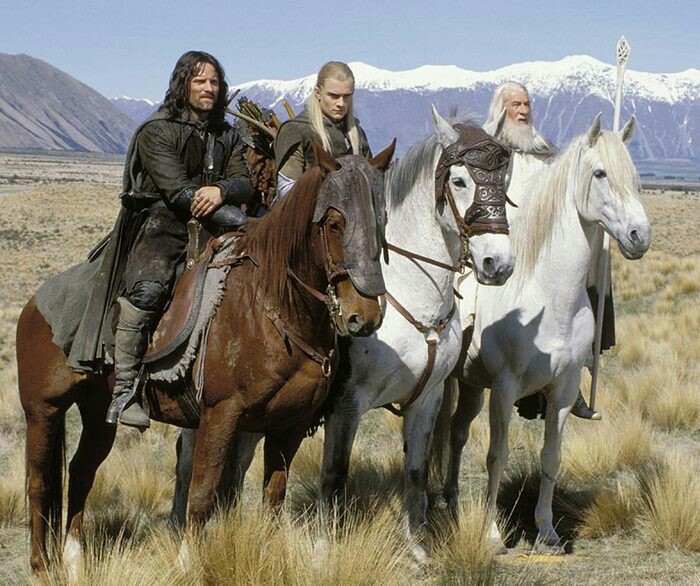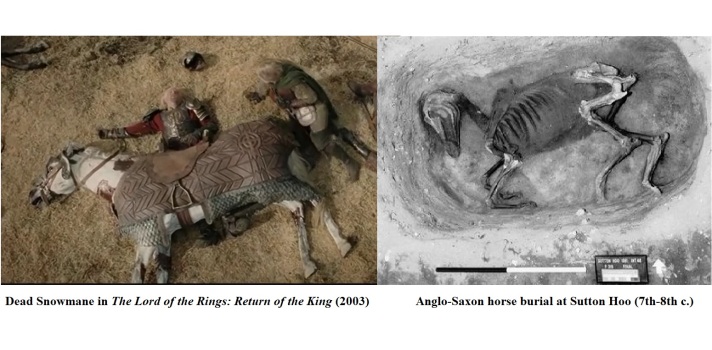As a professor of Anglo-Saxon at the University of Oxford, J. R. R. Tolkien could not help but be inspired by the language and literature he studied and taught. As a result, his fictional world is infused with cultural material of the Middle Ages, particularly Old English language and literature. In this blog, I will regularly shed some light on the medieval in Middle-Earth. This post reviews the horses of Middle-Earth.
The Rohirrim: Anglo-Saxons on horseback

It is no secret that Tolkien based the Riders of Rohan on the Anglo-Saxon inhabitants of Mercia. Indeed, the Rohirrim have even been called ‘Anglo-Saxons on horseback’ (see Honneger 2011). It is not difficult to see why the Riders of the Mark are connected to the early medieval English inhabitants of Mercia: the Rohirrim occasionally speak Old English and have Old English names. For instance, when Éomer tells Théoden “Westu Théoden hal!” in Tolkien’s The Lord of the Rings, he echoes Beowulf’s address to Hrothgar in the Old English poem Beowulf: “Wæs þu, Hroðgar, hal” (Beowulf, l. 407) [May you be healthy, Hrothgar]. The name Théoden itself is Old English, being derived from Old English ðeoden ‘ruler, king’, as are so many other names of the Rohirrim.
The Rohirric fondness for horses is reflected in their name Éotheod, which stems from Old English eoh ‘war-horse’ + ðeod ‘people’. Among these ‘horse-people’, Éomer, Éowyn and their father Éomund stand out for also having names of an equine nature:
Éowyn < OE eoh ‘war-horse’, wynn ‘joy’
Éomer < OE eoh ‘war-horse’, mǣre ‘famous, great’
Éomund < OE eoh ‘war-horse’, mund ‘protector, guardian’
Unlike the Rohirrim, the Anglo-Saxons do not have a reputation for employing cavalry. Honegger (2011) points out that the Anglo-Saxons in the Battle of Maldon (991) and the Battle of Hastings (1066) fight on foot rather than on horseback. Be that as it may, earlier sources on Anglo-Saxon warfare do show Anglo-Saxons using cavalry, such as the Aberlemno Stone (c. 700-800) depicting (as some would argue) the Battle of Dun Nechtain (685) between the Northumbrian king Ecgfrith and the Picts (see image above).
The connection between the Rohirrim and the Anglo-Saxons (and their horses) is further borne out by the banner of Rohan, the names of the Rohirric horses and the treatment of Theoden’s horse Snowmane after its death.
The Banner of Rohan: “White horse upon a field of green”

The banner of Rohan is described as bearing a “white horse upon a field of green” (LOTR, bk. V, ch. 10). Tolkien probably found his inspiration for this banner in Wiltshire, near his hometown Oxford. The hills of Wiltshire are littered with white chalk horses, one of which (the Uffington White Horse) dates back over three thousand years (more info here). Folklore connects some of these white horses to the Anglo-Saxon period: The Westbury White Horse, for instance, may commemorate the victory of King Alfred the Great over the Vikings at the Battle of Ethandun in 878. Alfred the Great himself may be the partial inspiration behind Aragorn (see: The Medieval in Middle-earth: Aragorn and Exiled Anglo-Saxon Kings).
From Arod to Windfola: The Old English names of the Rohirric steeds
The horses of the king of Rohan are of a special breed called the Mearas, a name that means ‘horses’ in Old English (it is the plural of mearh ‘horse’). Indeed, upon closer inspection all names of the Rohirric horses turn out to be Old English:
Arod < Old English arod ‘fast’
Brego < Old English brega ‘ruler, prince’
Felarof < Old English fela ‘very’ + rof ‘strong, brave’
Hasufel < Old English hasu ‘grey’ + fell ‘hide’
Shadowfax < Old English sceadu ‘shadow, grey’ + fæx ‘hair’
Windfola < Old English wind ‘wind’ + fola ‘foal
Perhaps my favourite Old English name for one of the horses of Rohan is Stybba, the pony given to Merry Brandybuck. The name derives from Old English stybb ‘stump’.

A mound for a horse: Snowmane’s Howe and Sutton Hoo
The royal burial mounds of Rohan were inspired by the seventh-century royal burial mounds of Sutton Hoo, as I have argued elsewhere (Porck 2017). One such Rohirric mound is particularly relevant in connecting the Anglo-Saxons to the Rohirrim: Snowmane’s Howe. Snowmane, the horse of King Theoden, meets its demise in the Battle of the Pelennor Fields and is buried on the spot. The Rohirrim call the mound ‘Snowmane’s Howe’ – the second element of the grave’s name, ‘Howe’, reflects the element Hoo in Sutton Hoo (both potentially derive from the Old Norse word haugr ‘mound’). While this ceremonial burial of a horse may appear particular to the horse-loving Rohirrim, there is at least one Anglo-Saxon analogue. The Sutton Hoo burial mounds also include one mound with the skeleton of a horse, buried alongside its rider.

To sum up, the Rohirrim share a fondness for horses with the Anglo-Saxons, who, after all, traced back their origins to Hengest and Horsa [‘horse, stallion’ and ‘horse’].
If you liked this post, you may also be interested in:
- The Medieval in Middle-earth: The Anglo-Saxon Habits of Hobbits
- The Medieval in Middle-earth: Aragorn and Exiled Anglo-Saxon Kings
- The Medieval in Middle-earth: Rings of Power
- The Medieval in Middle-earth: Thror’s Map
Works referred to:
- Honegger, Thomas. (2011). The Rohirrim: ‘Anglo-Saxons on horseback’? An inquiry into Tolkien’s use of sources. In Tolkien and the study of his sources: Critical essays, ed. J. Fisher (2011), 116–132.
- Porck, Thijs (2017). New roads and secret gates, waiting around the corner: Investigating Tolkien’s other Anglo-Saxon sources. In Tolkien Among Scholars, ed. N. Kuijpers, R. Vink and C. van Zon (s.l.: Tolkien Genootschap Unquendor, 2017), 49-64 [Book for sale here for €16,50]
